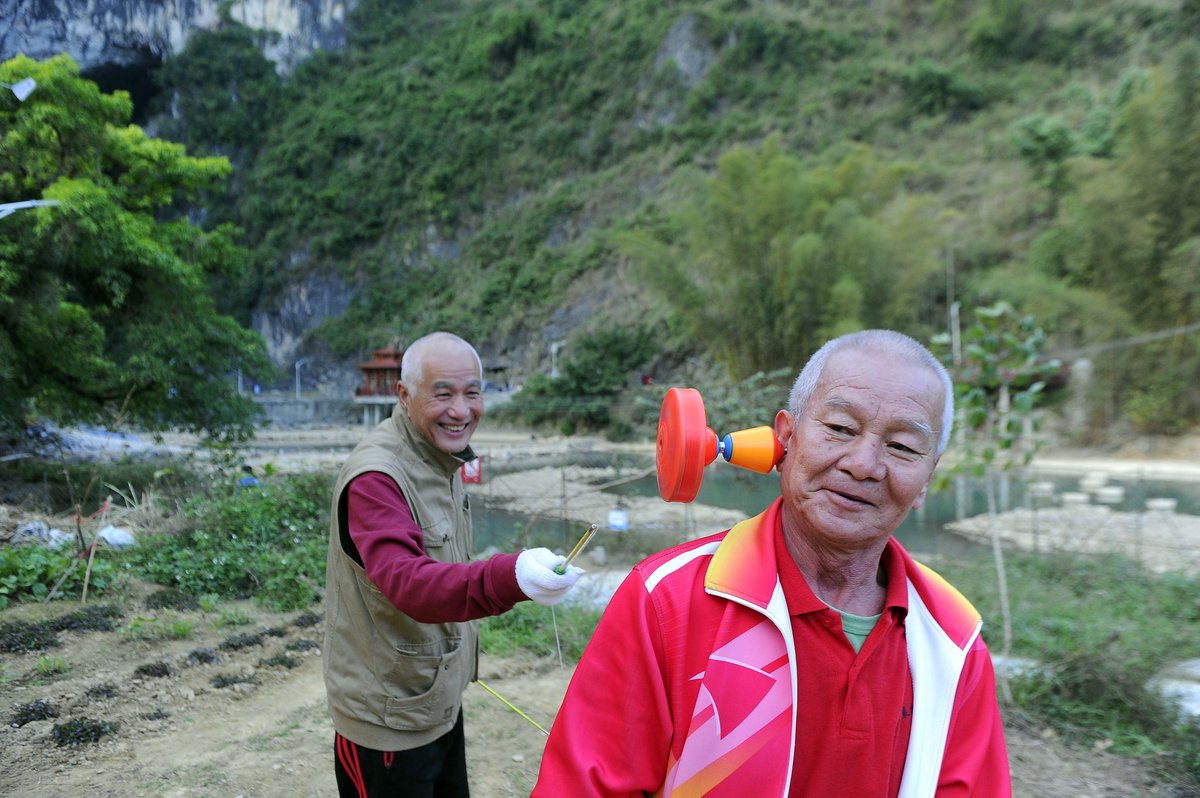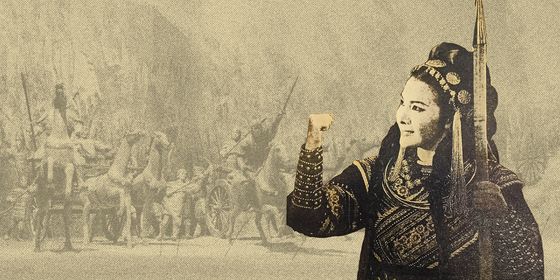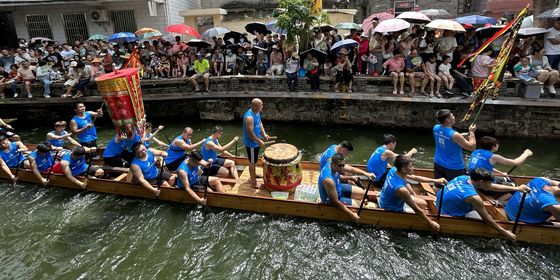Hovering bamboo discs, flying feathers, twisty harvest dance...Some of China’s traditional sports still enjoy a modern following, even internationally
On June 12, nine days after China’s Dragon Boat Festival (端午节), Boston’s Charles River will be filled by the sound of drums, as boats painted with dragon scales and mounted with dragon heads take to the water for a day of races.
This year will be the 43rd year of the Boston Dragon Boat Festival, which typically draws around 2,000 rowers from around the US, as well as local spectators who will enjoy festivities like Asian street food stalls and performances in Taiko, Angkor Dance, and Chinese Waist Drum.
The traditional sport of dragon boat racing now reaches far beyond China’s own shores. According to the International Federation of Dragon Boats, a governing body set up in 1991, this now globally renowned sport enjoys 50 million participants in China, 90,000 in US and Canada, and over 30,000 in Europe.
Like the dragon boat, many other Chinese folk sports with ancient origins have survived into the present day, and some are experiencing new vitality—even beyond China’s borders. Activities like kite-flying, pigeon racing, diabolo, and dragon dance are all still practiced today , with China’s General Administration of Sports (GAS) devoting a whole section, called the “Social Sport Guidance Center,” to the promotion of these sports nationally and internationally. Here are a few more still-thriving Chinese folk sports:
Diabolo 空竹
If you hear futuristic humming noises in a park in China, or spot a flying disk hovering around a dexterous grandpa, don’t be alarmed—it’s probably not a UFO.
Two hollow bamboo disks (or plastic disks, as more often seen today) connected by an axle make up the kongzhu, also known as a Chinese yoyo or diabolo. It comes to life when spun by a string attached to a handle on each end. By manipulating the handles, the player can make the diabolo hover, bounce on and off the string, or travel along complex trajectories (orbiting around the body, for example). The slits on the disks make them whistle when moving fast, gaining the toy nicknames like “noisy calabash (响葫芦),” or “pulling bell (扯铃).”
History:
Though Xinhua News dates the toy back to an oft-cited Ode to Kongzhu, a verse allegedly written by famous poet Cao Zhi (曹植) from the Three Kingdoms period (220 – 280), a 2020 Beijing Evening News article called the poem into question, as the last two lines lacked Cao’s literary finesse and sounded too modern.
The first reliable mention of the diabolo is found in the Brief Notes on Scenery and Objects in the Imperial Capital (《帝京景物略》), a Ming dynasty (1368 – 1644) publication that described in detail how a diabolo is made and played. It was first introduced to the West when French Jesuit missionary Joseph Amiot brought samples back from a trip in 1792.
Current state of affairs:
In China today, diabolo is recognized as a national intangible cultural heritage, and is sometimes incorporated into the education curriculum. Some schools have all students learn to play it during exercise hours.
Internationally, diabolo has also developed into a beloved recreation. In addition to stand-alone diabolo contests, national and international yoyo competition sometimes include diabolo as an event, where players are judged based on style and the difficulty of their tricks.
In 2021, the Filipino American duo Spyros Bros took their fluorescent diabolos to the stage of America’s Got Talent, gaining a standing ovation with their synchronized dance moves and long distance tosses of the diabolo between the stage and audience seats. The clip of the performance on the duo’s YouTube channel, featuring many shots of wide-eyed audience members gaping in shock, has garnered more than 2 million views.
Kicking shuttlecock 毽子
In parks around China, you can often see a handful of people standing in a circle, kicking around an airborne jianzi: a clump of feathers (often dyed) attached to small metal or plastic disk covered with a rubber sole. Whether played by one person or in groups of two or more, the aim is to keep the jianzi in the air. Like soccer, players usually kick with their foot, but sometimes enlist the help of their knees, chests, heads–but never their hands. In competitions, elite players may go into lunges, splits, spins, or overhead kicks pass a jianzi, which can flit between the players for dozens of passes without touching the ground.
A toy of many names, the jianzi is also known as “foot badminton,” featherball, or Chinese hacky sack.
History:
Many online blogs, encyclopedias, and even an article by Shaanxi Sports Museum claim that stone carvings of people playing jianzi were found in an Eastern Han dynasty (25 – 220) grave excavated in Jining, Shandong province, but no further evidence supports this claim.
The Ming dynasty text New Complete Book of Origins of Ancient and Current Things (《新镌古今事物原始全书》) records children playing jianzi and giving their tricks names like “belly out,” “Buddha pushes pearl with head,” and “scissors.”
Some attribute the origin of jianzi to “hand shuttlecock,” a traditional social sport popular among the Dong, Miao, and Shui ethnic groups. Others believe that it came from cuju, an ancient Chinese form of soccer that dates back to the Records of the Grand Historian (《史记》), a history of ancient China written in the Han dynasty (206 BCE – 220 CE).
Current state of affairs:
On the streets of Beijing, you can hit up vendors who sell jianzi for around 15 to 20 yuan a pop. Jianzi has also developed into an organized competitive sport, during which players rock team jerseys, arrange themselves in formations similar to volleyball, and play on courts similar to badminton courts.
The games look a lot like Sepak Takraw, a kicking volleyball game that originated in Southeast Asia, but with flying feathers instead of a ball. In Vietnam, people are often seen playing competitive jianzi, called Đá cầu, around public nets set up in parks.
Many sources trace the introduction of jianzi to the West to the 1936 Berlin Olympics, where a Chinese athlete did a demonstration performance. The International Shuttlecock Federation was set up in 1999, and Hungary hosted the first world championship in Újszász in 2000.
Fitness yangge 健身秧歌
While YouTubers around the world turn hip hop, bollywood, and reggaeton into fitness routines, fitness yangge (秧歌) incorporates the steps and movements of China’s traditional yangge dance into a stylish cardio workout.
The verb that usually goes with the yangge in Chinese is not “dance (跳),” but rather “twist (扭).” The performance features many movements like its most basic “cross step” (crossing one foot in front of the other to reach four points of a square), as well as many brisk twists and swings of the body.
Performances of yangge or fitness yangge often radiate energy. Dancers are dressed in red and green costumes; wave around props like fans, satin, or red cloths spinning on finger tips; and dance to ear-piercing accompaniment by the suona, gong, drums, and cymbals.
History:
The yangge dance is popular in northern China and commonly believed to have originated from the movements of farmers when planting and harvesting crops. The website of the China Intangible Heritage Protection Center cites the Copy of Miscellaneous Chants for the New Year (《新年杂咏抄》) by 18th century calligrapher Wu Xilin (吴锡麟), which traces the prototype of yangge back to “village music (村田乐),” a form of rural music and dance mentioned in the Recollections of Wulin (《武林旧事》), a Southern Song dynasty (1127 – 1279) description of Lin’an (in present Hangzhou city of Zhejiang), sometimes referred to as Wulin.
In the 1940s, a nationwide New Yangge Movement, launched by the Communist Party, turned the dance into a publicity vehicle and popularized it to tell tales of laborers, revolution, and class struggle. Around Lunar New Year in 1945, Mao Zedong famously commented after watching a yangge performance, “the 90 million people in liberated areas are roaring with yangge against Japan. We will roar until we defeat the Japanese invaders.”
The first officially recognized fitness yangge routine was born in 2000, and was promoted nationwide by the GAS. As of 2021, there were already eight versions.
Current state of affairs:
Yangge workouts are sometimes incorporated into the “square dances” enjoyed by retirees in public spaces, as they can be easily performed by dozens or hundreds of people in formation. In competition, however, yangge has its own rules stipulated by the GAS, which states teams should be judged both on how well they perform the standard routine and on their own creative choreography, which cannot include elements that are “adapted for modern stage, melodramatic, or of non-yangge nature.”
Though national competitions have no minimum age limit, fitness yangge seems to be enjoyed mostly by the elderly, becoming a popular event in senior sports competitions at local levels. Unlike dragon boat, diabolo, and jianzi, which enjoy an international following, evidence of foreign yangge lovers is yet to be found.















